As edible fungi, many people confuse truffles with mushrooms – some of which are also edible fungi harvested from the wild and cultivated around the world for people to eat. To make it even more confusing, truffles and mushrooms sometimes appear together as flavors in the same recipe. A creamy mushroom risotto with truffle butter is just one example of that! This article will help you understand what truffles and mushrooms have in common and how they are set apart from each other. Here are some key differences to know.
By the end of this article, you will have compared the classification of truffles and mushrooms, explored how and where each grows, discovered some common species, and learned how you can use both in your cooking at home. Let’s learn about truffles and mushrooms together now!
Truffles vs. Mushrooms
| Characteristic | Truffles | Mushrooms |
|---|---|---|
| Species | There are more than 180 truffles that have been identified. Among these, only about thirteen have commercial value and only about six are typically available to purchase for culinary use. | Experts are not exactly sure how many mushroom species there are. Estimates put the number of mushroom species in the world at somewhere between 10,000 and potentially hundreds of thousands. However, fewer of these are edible. There are currently a few thousand identified edible species. |
| Class | Pezizomycetes | Agaricomycetes |
| Division | Ascomycota | Basidiomycota |
| Kingdom | Fungi | Fungi |
| Common Name | Truffles | Mushrooms, toadstools |
| Origin | Global (Primarily in Asia and Europe) | Global (Diverse mushroom species grow across the whole world) |
| Description of Fungus | Truffles are the fruiting body of fungi that grow underground. Many truffles are in the genus Tuber. Truffles are ectomycorrhizal fungi. This means that they enjoy symbiotic relationships with trees, whose roots they grow on underground. What most people identify as a truffle is the fruiting body, the edible spores that grow on the fungus. | Mushrooms are the fruiting body of fungi, which typically grow above the ground and appear in soil or on a nutrient source such as wood. There are thousands of species of mushrooms in many different genera. In general, mushrooms can be grouped into four categories: saprotrophic, mycorrhizal, parasitic, and endophytic. |
Descriptions of Truffles vs. Mushrooms
Both truffles and mushrooms are part of the fungi kingdom. However, the fungi kingdom is vast and contains diverse species – some of which are very different from one another. As members of the fungi kingdom, both truffles and mushrooms operate differently from plants and animals. While plants use the sun’s energy to make food in the process of photosynthesis, and animals eat and digest food, fungi do something different. Rather, fungi have a mycelium which grows in or on a food source. Then enzymes digest the food, allowing the mycelium to take in the pre-digested nutrients.
Fungi produce spores, which feed on organic matter that was formed by living organisms such as plants or animals. You can think of leaves or manure as examples. The fungi kingdom includes diverse species, truffles and mushrooms being just two common forms alongside the yeast and mold that most people encounter on a daily basis.
Though truffles are often called mushrooms and the two are grouped together, they are actually very different in some key ways. While there are thousands upon thousands of mushrooms scattered across the globe, the world of truffles is relatively smaller. Truffles and mushrooms grow in different geographies in the world, but can also inhabit different parts of the same forest. When it comes to eating them, truffles and mushrooms each perform a different function. While you may choose to include both at your dinner table in some way, knowing the differences between them will be key.

Truffles grow in a symbiotic relationship with the tree roots underground.
©iStock.com/vainillaychile
Description of Truffles
Truffles are the fruiting body of fungus growing underground. The spores are the edible part, which can be harvested from the ground by hand. Though many truffles are in the genus Tuber, some are also in other genera. As ectomycorrhizal fungi, truffles live in symbiotic relationships with trees, whose roots provide the nutrients that truffles need to grow underground. Though more than 140 truffles have been identified, only nine are known to be edible and only six are widely available.
Truffles are often considered to be a delicacy in the world of cooking and fine dining. This is in part due to the fact that they are rare and difficult to come by. They also lose their flavor very quickly after being harvested. As a result, truffles are typically very expensive. Just one pound of certain truffle varieties can sell for thousands of dollars. Due to this demand, truffles are now cultivated and harvested around the world, with truffles made into many different food products such as truffle oil or truffle butter.
Truffles primarily grow in parts of Europe and the Middle East (the Eurasia continent), which contributes to their limited availability and fewer cultural traditions compared to those associated with mushrooms.
Description of Mushrooms
Mushrooms are also the fruiting body of fungus. However, while truffles grow underground, mushrooms typically grow above ground. They appear in soil or growing on top of a food source, with their exact growing needs varying by mushroom species. For example, many mushrooms grow on dead or decaying wood, which serves as a source of nutrients for them. There are thousands of different species of mushrooms in the world, with some experts estimating that there are far more distinct species. Thousands of edible mushrooms have been identified, but fewer are eaten regularly by humans.
Mushrooms can be organized into four categories: saprotrophic, mycorrhizal, parasitic, and endophytic. Saprotrophic mushrooms consume dead and decaying matter and assist the decomposition process. Common examples of saprotrophic mushrooms are shiitake, oyster, and button mushrooms. Mycorrhizal mushrooms have mutually-beneficial relationships with plants and experience symbiotic relationships in which the mycelium of the mushroom depends on the root of a plant while helping to hydrate and share nutrients with the plant in return. Examples of mycorrhizal mushrooms include porcini mushrooms and chanterelles. Parasitic mushrooms are harmful to their plant hosts and only take nutrients, often leading to the eventual death of their host. Lion’s mane is an example of a parasitic mushroom species. Lastly, endophytic mushrooms have a symbiotic relationship by contributing to the health and longevity of their host by making the plant taste bad or become poisonous.
Mushrooms are a popular food item and are both commercially cultivated and harvested from the wild. Mushroom species grow across the world. As a result, food traditions of many cultures incorporate mushrooms into recipes, traditions, and medicinal practices. Some of the most popular mushrooms that are cultivated today include shiitake mushrooms, button and cremini mushrooms, and oyster mushrooms.
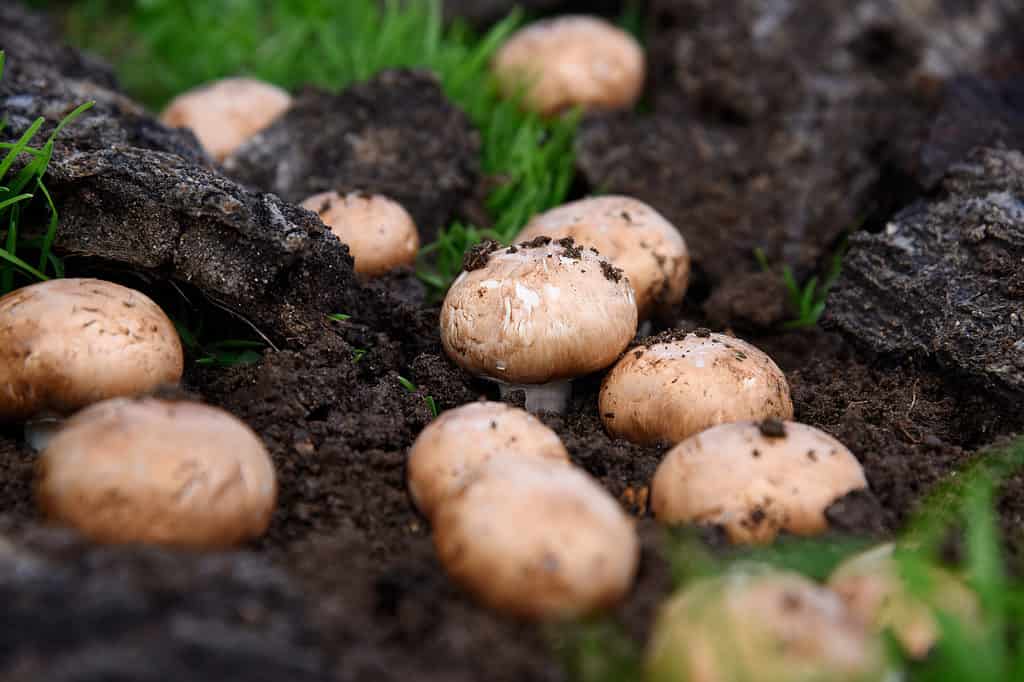
While truffles grow underground, mushrooms typically grow above ground.
©Wild As Light/Shutterstock.com
Truffles vs. Mushrooms: Key Differences
Just from those brief descriptions, you can gather that there are some major differences between truffles and mushrooms. With these descriptions and the previous key points in mind, let’s learn more about the appearance, growing environment, and uses of truffles and mushrooms now.
Truffles vs. Mushrooms: Appearance
Appearance of Truffles
Truffles are tuberous, and sometimes described as looking a little bit like lumpy potatoes. Depending on the type of truffle, the size can vary greatly – from very tiny to as big as a grapefruit! Truffles also range in color, from sandy white to dark brown. The exact color of a truffle varies depending on the species and the tree it grows with, as truffles grow underground in woodland areas throughout Europe and Asia. Truffles are rough on the outside, have an earthy or sometimes sweet scent, and have a firm but sponge-like texture.
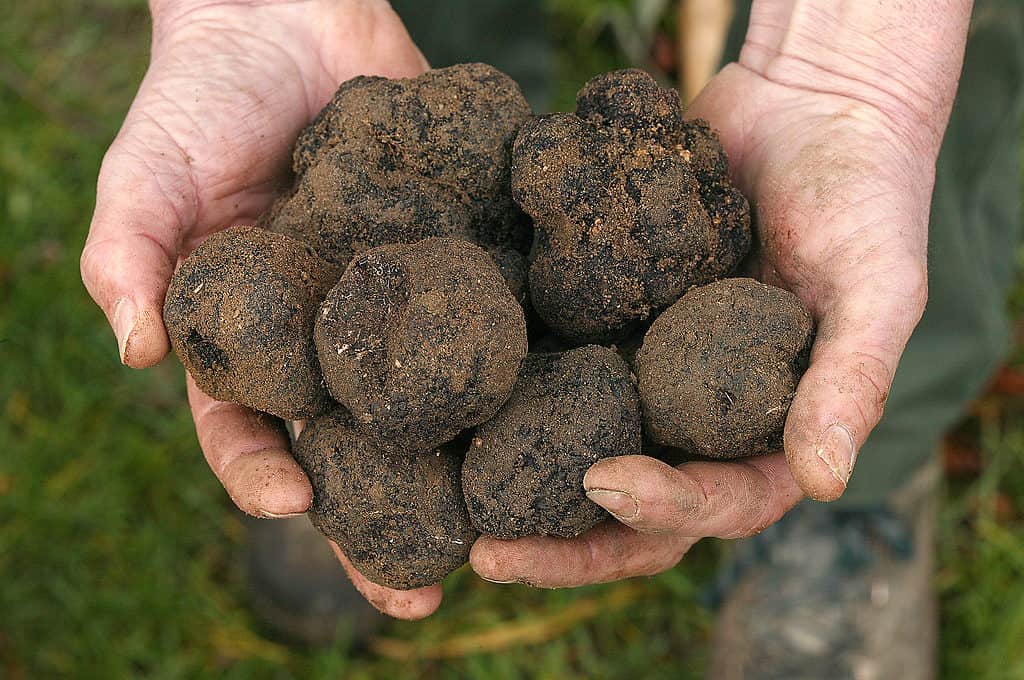
Truffles are tuberous, and sometimes described as looking a little bit like lumpy potatoes.
©slowmotiongli/Shutterstock.com
Appearance of Mushrooms
Mushrooms can also appear in many different shapes and sizes, grow in different environments, and come in a range of colors and textures. One of the most widely-grown mushrooms is the button mushroom. Button mushrooms grow in what some people think of as the quintessential mushroom shape. It looks like a small umbrella with a thick stem and a dome-like cap. Button mushrooms are small and white. However, mushrooms come in many different colors, including red, blue, yellow, green, brown, black, orange, and even purple. Mushrooms also come in many different shapes. Some grow to be round and spherical. Other mushrooms have the shape of a funnel or trumpet. Some look like a bee’s honeycomb or could be mistaken as a piece of coral. Some are large and grow as a single specimen that reaches to be a foot long, while others are tiny and grow in small clusters.
Here are some common attributes of mushrooms.
- Many mushrooms have stalks and caps, with popular edible mushrooms such as the button mushroom and portobella having this distinctive feature. However, others are spherical in shape. Others grow on the sides of trees in semi-circular formations that are wavy and extend off of the tree bark.
- Individual mushrooms spring up from a mushroom mycelium, the underground network that sprouts the mushroom “fruit.” The mycelium of a mushroom can spread underground for dozens or even hundreds of acres.
- Mushrooms produce spores, though these may not be easily discernible.
- Mushrooms often have gills which crowd together underneath the cap. Others have ridges that look similar to gills.
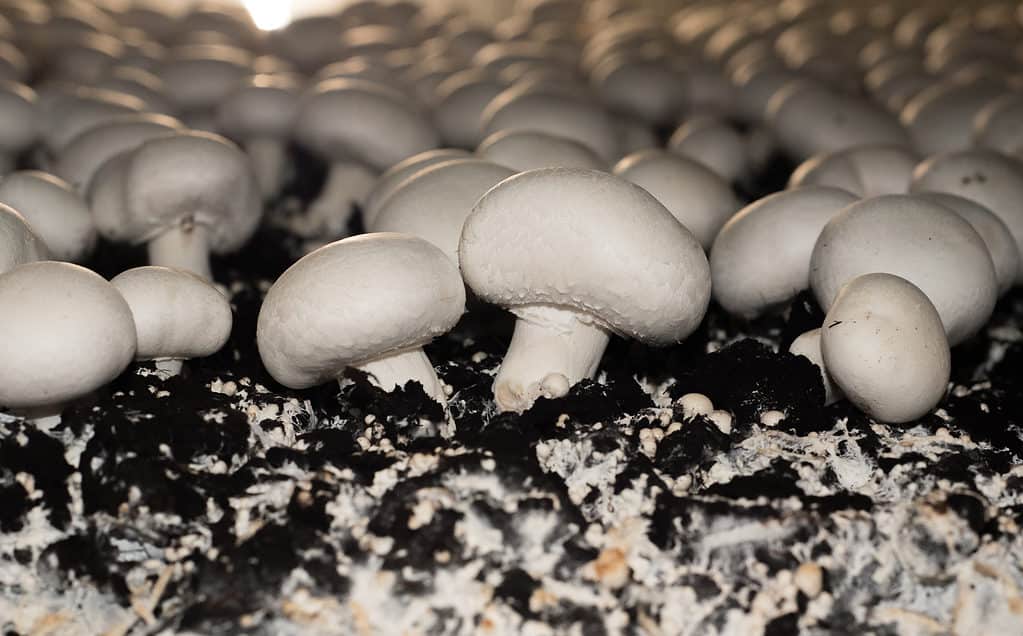
One of the most widely-grown mushrooms in the world is the button mushroom which has a thick stem and a dome-like cap.
©ArliftAtoz2205/Shutterstock.com
Truffles vs. Mushrooms: Scent and Taste
Scent and Taste of Truffles
Typically, the taste of truffles is described as earthy and somewhat similar to that of mushrooms. They typically give off a pungent aroma. Two of the most common truffles you may encounter are the white truffle (Tuber magnatum) and the black truffle (Tuber melanosporum). White truffles are from Italy, while black truffles are from France. These two species are among the most popular truffles and are known for being flavorful. They thrive in the chalky soil of their native European environments, where they grow in the autumn months between October and November. They are mainly found in woodland areas with calcareous soil, which means that the soil is high in calcium carbonate. The soil that the truffle grows in influences its flavor.
You will find that white truffles are slightly yellow, pungent, and smooth. These have such a strong flavor that they are usually only incorporated to dishes in very small amounts and are often used as a garnish on dishes such as pasta. In contrast, black truffles have rough exteriors that have a similar texture to tree bark. Because their flavor is more earthy and less robust than the flavor of a white truffle, they are incorporated into sauces and other dishes more easily.

Black truffles have rough exteriors and an earthy flavor that’s less robust when compared to the flavor of white truffles.
©Sofia Royo/Shutterstock.com
Scent and Taste of Mushrooms
Like truffles, the flavor of mushrooms changes depending on the species. However, the variety of mushrooms is much greater than that of truffles, which typically all share an earthy flavor and pungent aroma. In contrast, mushroom flavors can range from nutty to sweet to fruity to earthy or even seafood-like. Similarly, the texture of mushrooms can be wildly different depending on the species in question or even the stage of maturity at which a mushroom is harvested.
Mushrooms can be incorporated into recipes in many different ways. Some mushrooms, such as shiitake mushrooms, provide intense flavor. Others, like cremini mushrooms, have a firm, meat-like texture that serves well as a meat substitute. Because of the great variety in mushrooms and their many nutrients, mushrooms are a staple in the cooking of many European and Asian cultures.
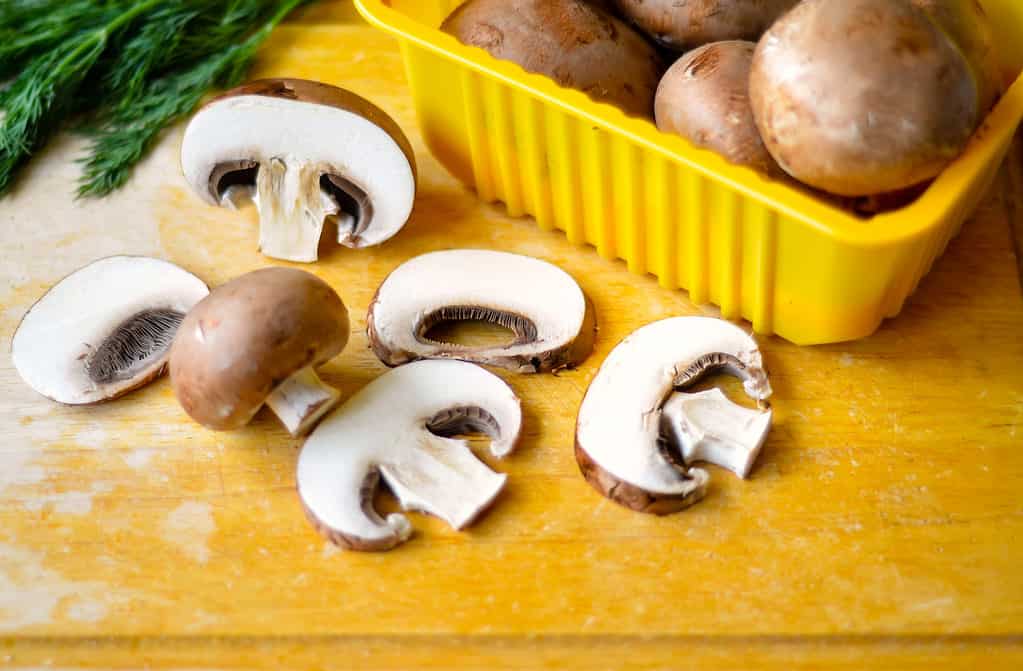
Cremini mushrooms have a firm, meat-like texture that serves well as a meat substitute.
©Tatiana.Sidorova/Shutterstock.com
Truffles vs. Mushrooms: History and Cultivation
History and Cultivation of Truffles
Truffles are so rare and special in part because of the way that they are harvested. Originally, people foraged for mushrooms by digging at the roots at the base of trees. To retrieve truffles from the under the soil, people used pigs to search for truffles in the wild. Female pigs could find truffles because they are attracted to the pheromone androstanol. Androstanol is also found in the saliva of male pigs, and is a sex hormone that attracts female pigs who are seeking to mate. As a result, female pigs could be used to find truffles growing in the dirt.
However, more recently, people learned that trained dogs could also learn how to seek out truffles. This is often a much simpler solution, since it can be difficult to prevent pigs from eating the truffles they locate and uncover. Farmers have also begun cultivating truffles. This is a difficult process, but it can be achieved by inoculating young tree roots with the spores of truffles. However, this takes a combination of weather, appropriate soil conditions, and several years. As a result, truffles have remained rare.

In recent times dogs have been trained to find truffles under the earth.
©slowmotiongli/Shutterstock.com
History and Cultivation of Mushrooms
People have harvested mushrooms from the wild since ancient times. Because mushroom species grow all over the world, ancient cultures and people groups have long sought and harvested wild mushrooms to eat and use for medicines. In some cases, such as with shiitake mushrooms in Japan, ancient people even learned how to cultivate wild-grown mushrooms. With technology, mushroom cultivation has become more widespread than ever before. Using controlled growing environments to mimic the weather of mushroom species’ native habitats, mushroom cultivators can create the right conditions and grow some species year-round. Today, commercial cultivators ensure that people around the world have access to button mushrooms, oyster mushrooms, and shiitake mushrooms year-round.
However, there are still some mushrooms that primarily grow in the wild. Until scientists discover new ways to grow them on a wide scale, foraging for mushrooms will remain one of the only ways to try certain mushroom species.
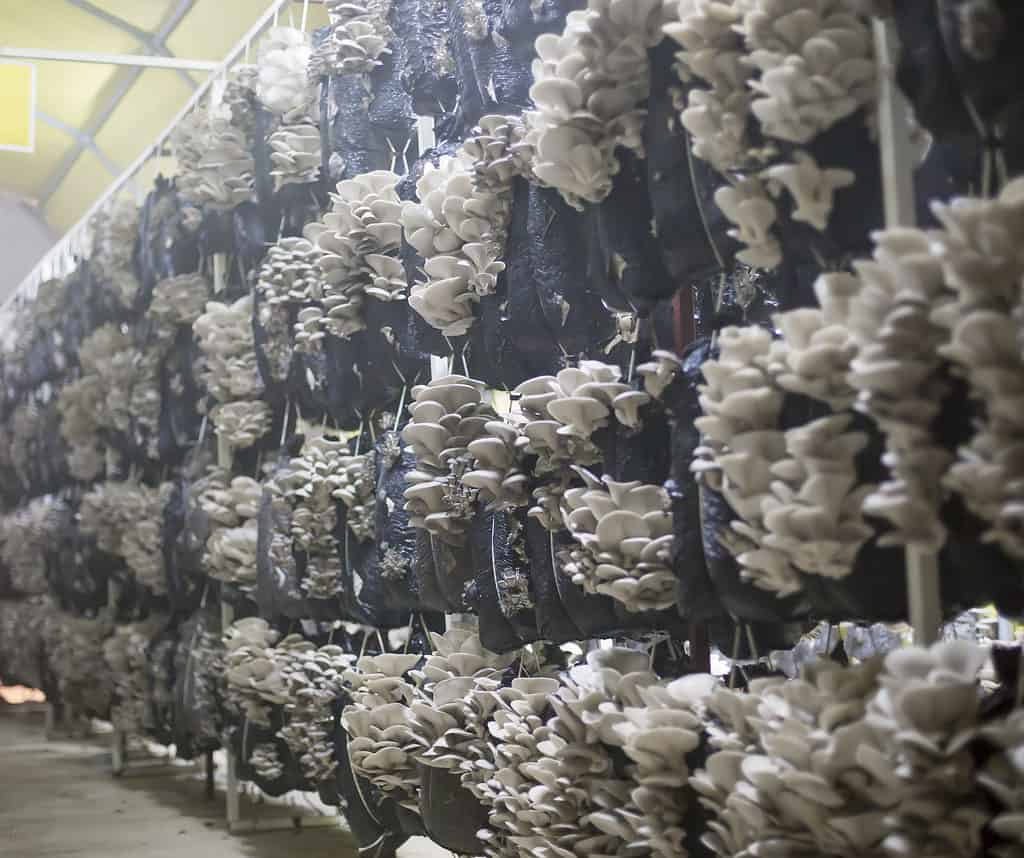
Using controlled growing environments mushroom cultivators can create the right conditions to grow some species year-round.
©iStock.com/lenoo
In Summary: Truffles vs. Mushrooms
As we discovered through this article, truffles and mushrooms are both members of the fungi kingdom. The edible parts we think of as “truffles” and “mushrooms” are the fruiting bodies of the fungi. Both play a role in culinary tradition and practice. People seek both for their unique flavor in various recipes. We also learned that they differ in some significant ways. Though they have a lot in common, truffles are not “mushrooms” and should not be labeled as such. In fact, while there are thousands upon thousands of mushroom species, many of which are edible, truffles are much more rare. There are even fewer truffles that are edible! As a result, they differ greatly in availability, cost, and use. However, both can be a valuable addition to a recipe when used correctly.
Next time you see “truffle fries” on a restaurant menu, try them! Or perhaps you can cook a creamy risotto recipe calling for both mushrooms and truffle oil. Whether it’s truffle hot sauce, truffle butter, or truffle macaroni and cheese, truffles have made waves in recent food trends, while mushrooms remain a staple of health foods. Now you know that each has a flavorful role to play, even though they are two different groups of fungi.
Why not try making mushroom risotto with both truffles and mushrooms today?
The photo featured at the top of this post is ©
The information presented on or through the Website is made available solely for general informational purposes. We do not warrant the accuracy, completeness, or usefulness of this information. Any reliance you place on such information is strictly at your own risk. We disclaim all liability and responsibility arising from any reliance placed on such materials by you or any other visitor to the Website, or by anyone who may be informed of any of its contents. None of the statements or claims on the Website should be taken as medical advice, health advice, or as confirmation that a plant, fungus, or other item is safe for consumption or will provide any health benefits. Anyone considering the health benefits of particular plant, fungus, or other item should first consult with a doctor or other medical professional. The statements made within this Website have not been evaluated by the Food and Drug Administration. These statements are not intended to diagnose, treat, cure or prevent any disease.
Sources
- Bradbury Science Museum (1970) truffles vs. mushrooms
- Better Homes and Gardens, Available here: https://www.bhg.com/recipes/how-to/cook-with-fruits-and-vegetables/what-is-a-truffle/
- Gothamist, Available here: https://gothamist.com/food/a-guide-to-truffles-the-funkiest-of-the-fungi
- Tasting Table, Available here: https://www.tastingtable.com/stories/truffles-vs-mushrooms-whats-the-difference/
- Cornell Mushroom Blog, Available here: https://blog.mycology.cornell.edu/2008/02/19/so-you-want-to-be-a-truffle-farmer-part-1/
- BBC Good Food, Available here: https://www.bbcgoodfood.com/howto/guide/what-do-truffles-taste
- Ministry of Forests, Available here: https://www.for.gov.bc.ca/hfp/publications/00029/mushwhat.htm
Thank you for reading! Have some feedback for us? Contact the AZ Animals editorial team.







